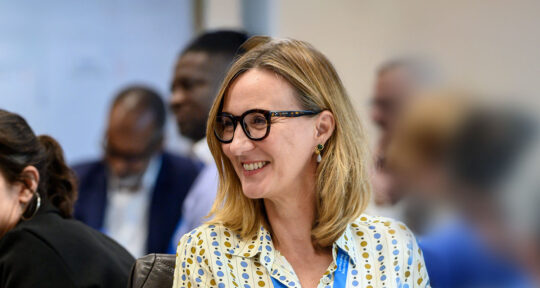
Every workplace is made up of people, each with their own story, perspective, and way of seeing the world. Diversity in the workplace, when genuinely welcomed and valued, can transform how teams collaborate, solve problems, and create impact. For senior leaders, embracing diversity, equity, and inclusion (DEI) isn’t just about representation; it’s about building a culture where everyone can contribute their best and feel they belong.
The influence of millennials and Gen Z has made workplace culture more transparent and values-driven. Platforms like Glassdoor give talent a clear view into how inclusive a company really is, and today’s professionals prioritize organizations that respect a wide range of perspectives, backgrounds, and experiences.
In this guide, we’ll explore why DEI is important, the benefits of diversity in the workplace, and practical strategies from addressing unconscious bias to expanding diverse leadership pipelines that can help you build an inclusive culture where everyone can contribute and excel.
- What is diversity in the workplace?
- Why is DEI important for organizations today?
- The benefits of diversity in the workplace
- Types of diversity in the workplace
- How to improve diversity in the workplace
- Examples of diversity and inclusion in the workplace
What is diversity in the workplace?
Diversity in the workplace refers to the presence of employees with a broad mix of backgrounds, identities, and perspectives — including race, ethnicity, gender, age, abilities, sexual orientation, and socioeconomic status. It also encompasses cultural diversity, which brings together individuals from different nationalities, languages, traditions, and belief systems.
But diversity on its own is not enough. True impact comes when it is paired with equity and inclusion: ensuring fair opportunities for growth, removing barriers, and creating an environment where everyone feels respected, valued, and empowered to contribute.
Research confirms this connection. McKinsey has shown that companies with greater gender and cultural diversity in leadership teams are significantly more likely to outperform on profitability, while Deloitte found that inclusive cultures are twice as likely to meet or exceed financial targets and six times more likely to be innovative and agile. Harvard Business Review adds that diverse teams are also better positioned to grow market share and capture new markets.
These insights highlight that DEI is not just a moral imperative, but a powerful enabler of innovation, agility, and sustainable business performance.
Why is DEI important for organizations today?
Diversity, equity, and inclusion (DEI) create the conditions for every employee to access opportunities, resources, and career advancement while feeling respected, valued, and supported. For organizations, this is more than an ethical commitment – it’s a strategic necessity.
When organizations embrace diversity, they gain access to a broader range of perspectives, skills, and experiences that can supercharge talent performance and fuel long-term growth.
Supported by a strong DEI framework, these advantages translate into the ability to attract and retain top talent, strengthen decision-making, and adapt effectively to market changes — all while reducing reputational and operational risks by aligning organizational values with stakeholder expectations.
The benefits of diversity in the workplace
A truly diverse, equitable, and inclusive workplace can transform how an organization operates and competes. These benefits touch every area of the business, from innovation and decision-making to employee engagement and market expansion. Let’s look at the most impactful advantages.
Enhanced creativity and innovation
Distinct life experiences lead to novel ideas that break from conventional thinking. This is especially valuable in industries undergoing rapid transformation, where agility and fresh perspectives can determine market leadership. Encouraging open dialogue and cross-functional collaboration ensures innovation becomes embedded across the organization.
Better decision-making
Diverse teams bring together individuals who view challenges from different angles, naturally questioning assumptions and stress-testing proposals. By surfacing blind spots and overlooked risks, they foster richer discussions and more rigorous evaluations, leading to decisions that are balanced and better aligned with real-world complexity.
Increased engagement and retention
Inclusion has a direct impact on engagement. Employees who feel respected and valued are more motivated and committed to the organization’s goals. They are also less likely to leave, which reduces recruitment and onboarding costs. Environments that welcome authenticity strengthen morale and employee wellbeing, attracting top talent who seek more than just competitive pay.
Extended market reach
A diverse workforce brings deep insight into different customer segments, enabling organizations to design products, services, and experiences that resonate with varied audiences.

Types of diversity in the workplace
Workplace diversity is multifaceted. It goes beyond visible characteristics to include the many ways people think, work, and experience the world. Each dimension of diversity adds unique value, and when combined, they create a workforce that is more innovative, adaptable, and resilient.
Among the most common types are:
- Cultural diversity: Nationalities, ethnicities, languages, traditions, and belief systems.
- Gender diversity: Balanced representation of all genders across roles and leadership levels.
- Age diversity: Multigenerational teams that bring together the experience of older professionals and the fresh perspectives of younger employees.
- Ability diversity: Inclusion of people with disabilities and different physical or cognitive abilities, supported by accessible workplace practices.
- Cognitive diversity: Varied approaches to thinking, problem-solving, and decision-making.
- Experiential diversity: Different educational backgrounds, career paths, and personal journeys that shape how individuals contribute.
How to improve diversity in the workplace
Improving diversity in the workplace is less about quick fixes and more about sustained, intentional action. It involves combining data, leadership commitment, and cultural change to ensure that representation translates into real inclusion. Here are four areas where organizations can make meaningful progress:
- Start with clarity: Understanding the current state of diversity is the first step. Surveys, audits, and employee feedback can reveal representation gaps, equity challenges, and cultural barriers that need to be addressed.
- Challenge unconscious bias: Bias often operates invisibly, shaping recruitment, promotions, and performance reviews. Leaders can mitigate this by embedding inclusive practices into processes — from blind resume screening to bias-awareness training.
- Develop future leaders: Representation at senior levels has a multiplying effect. By identifying high-potential employees from underrepresented groups and supporting them with mentorship and sponsorship, organizations create stronger, more diverse leadership pipelines.
- Make DEI part of the culture: The ultimate test of progress is whether employees feel they belong. Embedding diversity into company values, recognizing inclusive behaviors, and holding leaders accountable ensures DEI becomes part of daily life, not a side initiative.
Improvement is an ongoing process, but with deliberate action, organizations can build workplaces that are not only more equitable but also more innovative, resilient, and attractive to top talent.
Examples of diversity and inclusion in the workplace
Embedding diversity and inclusion into organizational culture requires more than statements of intent: it calls for deliberate, well-structured initiatives. Below are examples of proven practices that help companies move from aspiration to measurable impact.
1. Inclusive recruitment practices
Adjusting recruitment processes to minimize bias is a critical first step. Strategies such as blind CV reviews focus hiring decisions on skills and experience rather than demographic indicators, while diverse interview panels ensure multiple perspectives in candidate evaluation. Inclusive language in job descriptions also broadens applicant pools by avoiding terms that inadvertently deter certain groups.
2. Employee Resource Groups (ERGs)
ERGs are voluntary, employee-led networks that provide a space for underrepresented groups to connect, share experiences, and influence company policy. They can serve as advisory bodies to leadership, drive cultural awareness campaigns, and foster belonging. Support from senior executives is essential for ERGs to have visibility and impact.
3. Flexible work arrangements
Offering remote work options, adjustable schedules, or part-time roles helps employees manage personal responsibilities without compromising their career growth. For working parents, caregivers, or employees with disabilities, these arrangements can be the deciding factor in remaining with the organization.
4. Mentorship and sponsorship programs
Mentorship connects emerging talent with experienced leaders who provide guidance, while sponsorship goes further by actively advocating for protégés in promotion and project opportunities. Targeted programs can accelerate the advancement of underrepresented groups in leadership.
5. Ongoing diversity training
One-off workshops are rarely enough to shift culture. Regular, scenario-based training sessions help employees recognize unconscious bias, develop cultural competence, and apply inclusive practices to daily decision-making.
Leading inclusively for lasting impact
For today’s senior leaders, diversity in the workplace is not a compliance exercise, it’s a strategic imperative. By fostering diversity, equity, and inclusion, organizations unlock innovation, make better decisions, strengthen engagement, and extend their market reach. The most successful companies are those whose leaders don’t just support diversity policies, but actively create environments where every individual can contribute, grow, and thrive.
Achieving this level of inclusive leadership begins with self-awareness. IMD’s Mobilizing People program helps you transform how you connect with, mobilize, and inspire others.
Through challenging, unscripted leadership situations, you gain deep insights into the signals you send, the impact you have on others, and the habits that may be holding you back. You’ll explore both your “inner game” of self-discovery and authenticity, and your “outer game” of energizing and empowering people to achieve organizational goals.
Stay up to date 💌
Join the IMD Community.
Stay informed with our latest insights on leadership, strategy, digital transformation and more. Explore fresh perspectives from IMD business school to help you navigate today’s complex business landscape.



